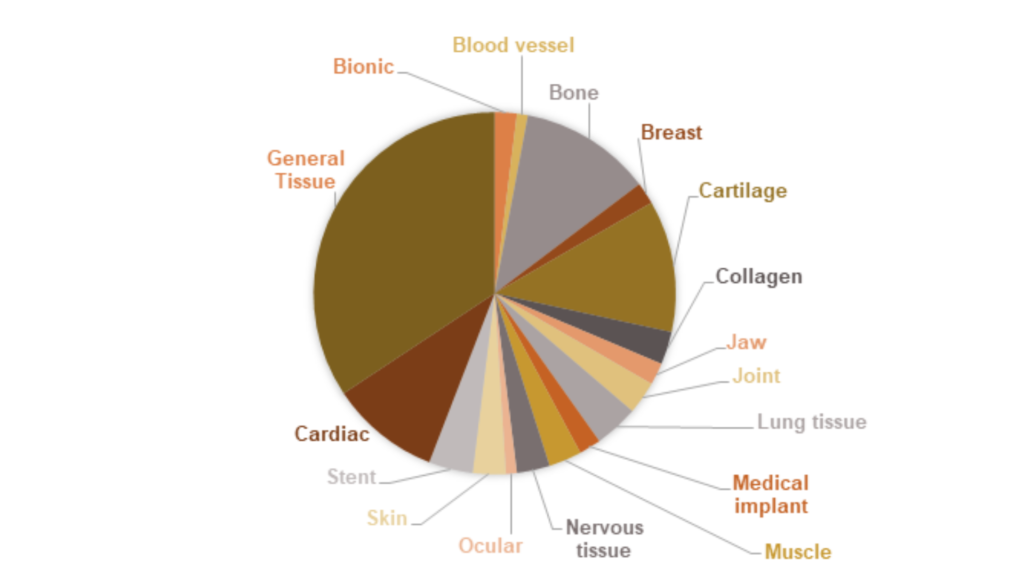Technology and its application
3D bio printing (3DBP) is a technology where biomaterials (bio inks) are mixed with living cells and hydrogels, are printed in 3D to obtain a natural tissue-like three-dimensional structures to enable regeneration and restoration of various tissues and organs and various other applications. These printed structure can potentially be turned into functional tissues or organs for organ replacement/ regeneration by encouraging cellular activities with various growth factors for regeneration. 3D bio printing has gained tremendous attention of many researchers and investors. There are more than a dozen of company ruling in medical printing including Organovo (USA), EnvsionTEC (Germany), RegenHu (Switzerland), Cellink (USA), Aspect Biosystems (Canada), etc.
For a successful implementation of 3DBP, finding a suitable base (biomaterial), speed of processing and other advanced printing process considered should be properly optimized. Therefore, Artificial intelligence (AI) OR Machine leaning (ML) provides a proven perspective with automotive solution throughout the process to enable scalable and standardized production of printed tissue or microfluidic models and avoiding prototype preparation as compared to conventional method done without automation.
Application of 3D Bio printing

Organ Regenerations

Bone Engineering

Drug Discovery

Medical Devices

Research

Prosthetics

Skin Graft

Disease modelling

Ear implant

Cornea Transplant
Process of 3D Bio printing
Pre Printing

Imaging

Model

Bio material selection/ preparation
Printing

Inkjet

Laser

Extrusion

Stereolitho graphic
Post Printing

Maturation in bioreactor

In vitro transplantation

Animal transplantation
Complexity in 3DBP and AI/ML based approach?
- Reproducing the main geometrical features, Micro and macro environment, cell aggregate, development of biomaterial etc. are some of the many limitations that comes with 3DBP to print or prepare a digital twin of organ. Therefore, blueprint tissue/organs cannot be directly derived from clinical scanning images.
- Its is important to address these challenges and this is where AI is being incorporated in bio printing to train data, train machine algorithm, prediction of errors, optimizing parameters to increase printing precision.

Intellectual property (IPR) data shows that around 56% of patent applications in the field of 3DBP are still pending state as the market is growing ata very fast pace.
AI based 3DBP studies is mostly seen in organ replacement and carcinoma management (Hepatocellular carcinoma).

3DBP potential market (IPR Jurisdiction)

How will AI be overcoming defects in Conventional 3D bio printing?
Developments in 3DBP have been mostly propelled by the limited availability of organs globally. Therefore, high-accuracy preconditioning is required to build accurate 3D models as they can account for factors or conditions not considered in conventional mathematical models, that is, they tend to be more robust in the real-world context in terms of prediction.
Currently, trial and error method is the go to approach to get desired output from 3DBP.

Evolution of AI/ML and 3DBP
1943,
1st Neural network model
1956, AI was coined
1959,Machine learning coined
2010, CAD applied to endoscopy
2012, Google creates un supervised neural network
2017, 1st cloud based DL application
2018, Alpha fold 1 technology for protein & AI trial in gastroenterology
2020, AI/ML introduction in 3D printing
1984, birth of 3DP
3DP got patented
First Stele lithography (SLA) coined
1996, First natural biomaterial used
1999, 3DP scaffold of new bladder cell to further grow them
2002, First animal kidney printed
2004, 3D tissue cell without scaffolds
2008, 3DP prosthetic leg
2009, 3DP blood vessel by a company called Organovo
2012, 3DP Jaw and liver tissue
2014,1st women from Norway to get 3D skull transplant
2015, Spritam (anti paralytic drug FDA approval
2016, 3DP bone/cartilage model obtained by ITOP system
2021, Optimizing the novel 3D organoid technique already used to recreate myeloma tumours introducing in 3D printing
2022, 3D Bio printed Models for Predicting Chemotherapy Response in Colorectal Cancer






